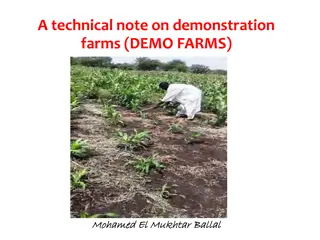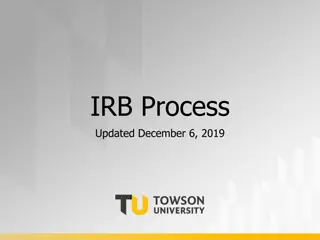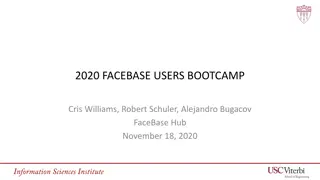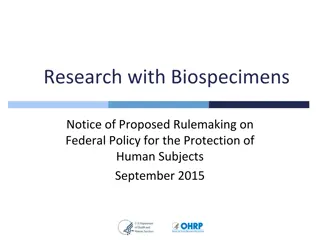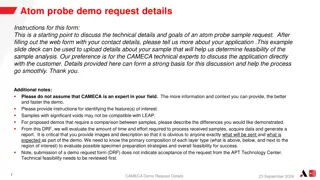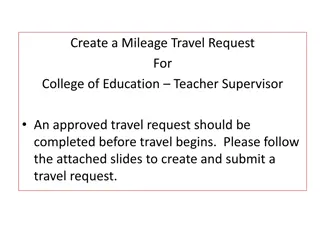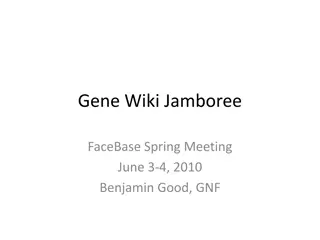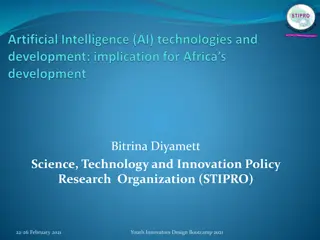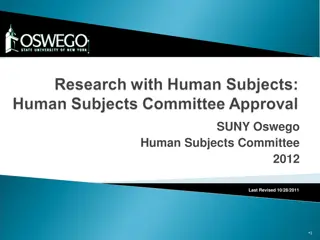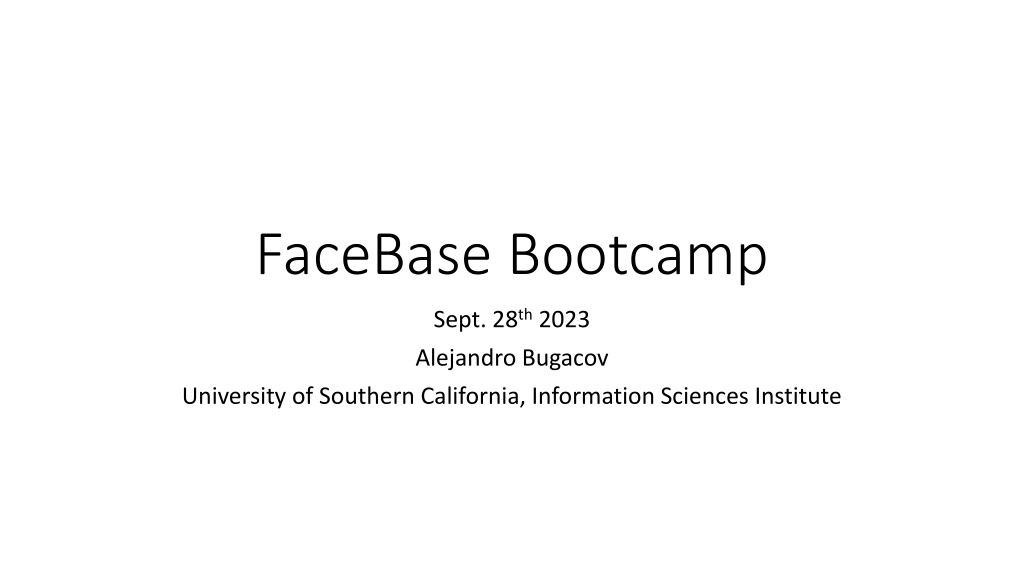
Accessing Human Subject Data from FaceBase Bootcamp
Explore the process of requesting and accessing human subject data from FaceBase Bootcamp, which offers a diverse collection of controlled access data for research purposes. Learn about the data available, the submission process, and how to complete the Data Access Request (DAR) form for accessing this valuable resource.
Uploaded on | 0 Views
Download Presentation

Please find below an Image/Link to download the presentation.
The content on the website is provided AS IS for your information and personal use only. It may not be sold, licensed, or shared on other websites without obtaining consent from the author. If you encounter any issues during the download, it is possible that the publisher has removed the file from their server.
You are allowed to download the files provided on this website for personal or commercial use, subject to the condition that they are used lawfully. All files are the property of their respective owners.
The content on the website is provided AS IS for your information and personal use only. It may not be sold, licensed, or shared on other websites without obtaining consent from the author.
E N D
Presentation Transcript
FaceBase Bootcamp Sept. 28th2023 Alejandro Bugacov University of Southern California, Information Sciences Institute
Why requesting Human-Subject Data from FaceBase? 1. FaceBase has a large and diverse collection of human-subject controlled access data 2. Diverse in cohort population, syndromes and data types Examples: About 4000 facial scans from a Tanzania population (https://doi.org/10.25550/TX4) About 1000 facial scans of North American Children (https://doi.org/10.25550/TK0) About 100 facial scan of Phelan-McDermid Syndrome (https://doi.org/10.25550/1A-BWJ8) RNA-seq, ChIP-seq and ATAC-seq analysis of human fetal tissue (https://doi.org/10.25550/3C-4G62) Oral health study of northern Appalachian households (https://doi.org/10.25550/2Q-M86G) Whole exome sequencing assay of female with Robin sequence, microglossia, microstomia structure of the oropharynx (https://doi.org/10.25550/1-415T) 3. Access to this data is controlled and cannot be made publicly available like all the model organism data that we have in FaceBase 4. To access this data users need to submit a Data Access Request (DAR)
Requesting FaceBase Controlled Access Data (https://docs.facebase.org/docs/human-data) DAC approves DAR Submit DAR 1 2 3 Gather institutional documentation Complete Data Access Request (DAR) form NIDCR Data Access Committee (DAC) reviews submission User downloads data Valid for 1 year
Completing the Data Access Request (DAR) form (https://docs.facebase.org/docs/dar) 1. Complete the Data Use Certificate Agreement (DUC) https://www.facebase.org/policies/data-use-certification Requires institutional signatures: Information Technology (IT) Director, Principal Investigator and Institutional Signing Official. 2. Login as FaceBase user (create new account if don t have one) 3. Go to https://docs.facebase.org/docs/dar and create new DAR 1. Complete fields 1 to 14 of the DAR form 2. If IRB required upload copy of IRB letter and Approved IRB Protocol 3. Upload DUC document 4. Save the form 4. Select list of requested datasets 5. Upload public encryption key file
Demo: Sharing your data through FaceBase
From Submission Request to a New Dataset 1. Request to Submit data https://www.facebase.org/submit/submitting-data/form.html 2. Once Approved you ll receive email with link to join the authentication group (Globus) to access your new Project page 3. New Project is not public by default so you need to Login first to see it 4. Find your new Project 5. Navigate to Datasets and click + Add Record 6. Step-by-step documentation: https://docs.facebase.org/docs/Data-Submission-Key-Concepts
Structure of Demo Dataset 2 Mouse samples of root of molar tooth 1 PN14.5 Mutant sample Lhx6-/- 1 PN14.5 Control sample 2 Different experiments on these samples Fluorescence microscopy images of both Mutant and Control Single-cell RNA-seq of the Mutant samples only
Installing DERIVA Client Tools Suite of reliable tools for batch uploading and downloading data GUI and command line tool for Mac, Windows and Linux Detailed documentation: https://github.com/informatics-isi-edu/facebase-curation/wiki/Deriva-Clients Mac and Windows: Download bundle from https://github.com/informatics-isi-edu/deriva-client-bundle/releases Linux: Use pip install: pip3 install --user deriva-client
Data Submission Resources Starting point https://www.facebase.org/submit/submitting-data/ FaceBase data curation Wiki https://github.com/informatics-isi-edu/facebase-curation/wiki Detailed step-by-step documentation Material for self-directed tutorial can be found at: Email help to be added to the Demo group to do the self-directed tutorial Need a tutorial? Contact the Hub (help@facebase.org) to setup a 1-hour walk-through conference call Need help while working on your datasets? Email us at help@facebase.org !!! FaceBase Monthly Office Hours: Last Wednesday of the Month
Installing DERIVA Client Tools Suite of reliable tools for batch uploading and downloading data GUI and command line tool for Mac, Windows and Linux Detailed documentation: https://github.com/informatics-isi-edu/facebase-curation/wiki/Deriva-Clients Mac and Windows: Download bundle from https://github.com/informatics-isi-edu/deriva-client-bundle/releases Linux: Use pip install: pip3 install --user deriva-client
Data Submission Resources Starting point https://www.facebase.org/submit/submitting-data/ FaceBase data curation Wiki https://github.com/informatics-isi-edu/facebase-curation/wiki Detailed step-by-step documentation Material for self-directed tutorial can be found at: Email help to be added to the Demo group to do the self-directed tutorial Need a tutorial? Contact the Hub (help@facebase.org) to setup a 1-hour walk-through conference call Need help while working on your datasets? Email us at help@facebase.org !!! FaceBase Monthly Office Hours: Last Wednesday of the Month
Data processing pipelines and visualization Name Data Types Action Type/Frequency Image file in large number of imaging formats from single image in PNG, JPG or TIFF to multichannel 3D and 4D stacks Pipeline creates thumbnails and visualization viewer with annotations. Contributor can manually tag anatomical terms from UBERON, text, regions, etc Automatic/Daily Imaging pipeline (https://www.facebase.org/id/3KW6) bigWig and bigBed files FaceBase embeds a UCSC Genome Browser visualization of all the uploaded tracks in the Dataset page Automatic/Daily Genome Browser (https://doi.org/10.25550/1-7780 ) Seurat (v3 and v4) and Cell Ranger matrix files (matrix.mtx, features.tsv and barcodes.tsv) FaceBase embeds a UCSC Cellbrowser visualization of each uploaded file at the Data File page Automatic/Triggered by file upload Cellbrowser pipeline (https://www.facebase.org/id/V-J7QP , https://www.facebase.org/id/R-W170) 3D meshes in OBJ format FaceBase shows a 3D visualization of the created model. Multi mesh, can tag anatomical terms from UBERON Manual model creation, Automatic visualization 3D Mesh viewer (https://www.facebase.org/id/1-517M) 3D files in NIfTI format FaceBase shows a 3D volume rendering of the created model Manual resolution reduction, Automatic visualization 3D Volumetric viewer (https://www.facebase.org/id/TY8) Each FaceBase Dataset and Project A unique and persistent Data Object Identifier (DOI) is assigned to each Dataset and Project page Automatic/Daily DOI assignment
Citing and Referencing your FaceBase DATA A DOI is assign to your Dataset the moment you create it Don t need to wait for Dataset to be released to the public You can include the DOI in your manuscript right away Contact us at help@facebase.org for anonymous journal reviews DOIs are assigned at each Dataset and Project level, are unique and persistent Share Link: Automatically generated for every page Click Share and Cite (top-right corner). E.g., https://www.facebase.org/id/R-W170 Citation: Automatically generated for every Dataset and Project Click Share and Cite (top-right corner) This is how FaceBase would like you to Cite your data DATA Data Citation Example: Samantha Brugmann, Christian Bonatto Paese. Single cell transcriptomics of the talpid2 avian mutant mandibular prominence. FaceBase Consortium https://doi.org/10.25550/R-PPWJ (2022).
Exporting Data from FaceBase Individual File Download Click on any (highlighted) file and the browser will prompt you to save the file to your computer Do not need to be logged in Bulk Export: CSV Downloads a CSV file with all metadata from the result of a Search Available both at the Results and Record page Most useful to download results of a search in tabular form BDBAG Useful download all data from a dataset or a project Very robust tool Data validation, console showing progress and status, can be restarted from where it left off Need to login with FaceBase User credentials First Step: Download a BDBag (Big Data Bag) file to your computer Second Step: Use the DERIVA Bag Tool to export the all data files and metadata to your computer In the afternoon session we ll see how to install this tool Detail documentation: https://www.facebase.org/help/exporting/
BDBag Export BDBag (Big Data Bag) is a standard for reliable sharing of data collections by transferring of a "bag" of digital content A BDBag consists of a hierarchical directory containing all data and metadata Provides verification that you have all the files you were trying to export AND that they were not corrupted in the process. In FaceBase we use them to export in bulk all files from a Dataset (or Experiment, etc). Materialized BDBag Downloaded BDBag file



